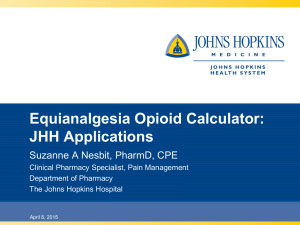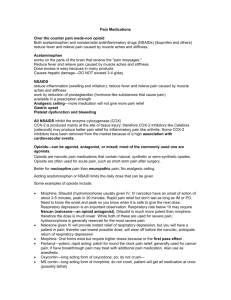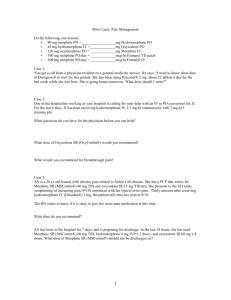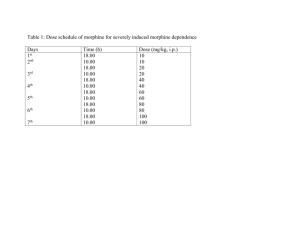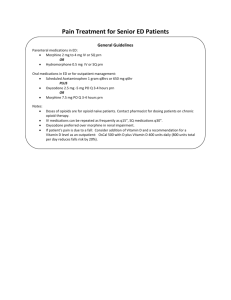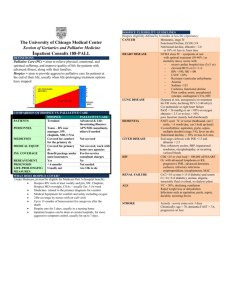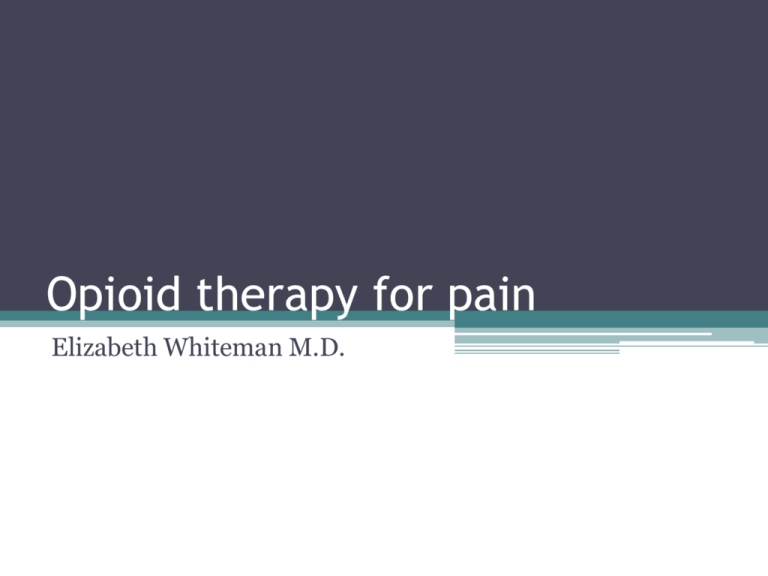
Opioid therapy for pain
Elizabeth Whiteman M.D.
Goals and objectives
•
•
•
•
•
•
Understand appropriate opioid use for pain
Understand side effects of opioids
Learn to treat and prevent side effects
Routes of administration
Equianalgesic dosing
Develop competence in treating pain and use of
opioids
Opioid Dosing
• Opioid starting dose depends on:
▫ Patient’s age, weight, cachexia
▫ Total doses of previous analgesics
▫ Frequency and severity of pain
Starting opioids
• Opioid naive patient start slow
• Oral first line if patient can swallow
• Short acting prn, or around the clock if constant
pain
• Can then calculate long acting needs
• Convert to long acting PO and make sure patient
has breakthrough short acting for prn
• Sublingual formulas not good bioavailability
• But can use liquid morphine orally
• Rectal dosing if patient able
▫ Routine dosing around the clock (q4-6hr)
• IV or Subcutaneous infusion if need rapid
titration or unable to take other route
Opioid titration
• Titration for increases in pain
▫ Oral morphine: 4 hr duration, 2hr peak
▫ IV/SC morphine 10-20 min peak
▫ Titrate prn: ½ of the 4hr dose
(about 10% of the 24 hr dose)
eg: 10mg q4hr ATC with 5mg prn q2hr
Opioids
• Tolerance
▫ pharmacologic property, less drug effect over time
• Dependence
▫ pharmacological response, uncomfortable side effects
when drug is withheld
• Addiction
▫ Behavior problem, compulsive use and craving for
psychological gain
Opioid side effects
• Constipation
▫ Always start laxatives with opioids
▫ Fluid intake
•
•
•
•
•
Nausea
Sedation and confusion
Urinary retention
Myoclonic jerks
Pruitis
Myoclonic Jerking
Often seen in:
◦ renal or hepatic insufficiency
Treatments
◦ Benzodiazepines
◦ Control electrolytes
◦ Opioid rotation
Progressive Myoclonis-seizures
◦ Reduce or rotate opioid
◦ Benzodiazepines
Delirium
Can be both hypoactive or hyperactive
Often seen in:
◦
◦
◦
◦
◦
Renal or hepatic insufficiency
Elderly
Alcohol or benzodiazepine withdrawal
Patients with underlying dementia
Brain metastasis
Treatment
◦ Decrease or rotate opioid
◦ Assess other medication which can contribute
◦ Antipsychotic medications
Respiratory Depression
• Often seen in:
▫
▫
▫
▫
COPD
Chronic lung disease
Upper airway compromise
Pneumonia
• Treatment
▫
▫
▫
▫
Reduce opioid
Switch to short acting agents
Avoid drug with active metabolite
Use diluted naloxone (only if indicated)
Treatment of side effects
•
•
•
•
Reduce opioid dose
Add adjuvant drug if indicated
Treat symptoms (may be temporary)
Hold medicine if feel patient got too much and
reassess
• Opioid rotation- try other agents
Special populations
•
•
•
•
•
•
•
Frail elderly
Liver patients
Dementia
Renal failure
Drug users
Pediatrics
HIV patients
Drugs to avoid / caution
• Avoid
▫
▫
▫
▫
Meperidine (Demerol)
Butorphanol(Stadol)
Propoxyphene(Darvon)
Pentazocine(Talwin)
• Caution, case by case
▫ Methadone(Dolophine)
▫ Transdermal Fentanyl(Duragesic)
Duragesic patch
• Use if no other route po or rectal
• If patient is on it, assess if really working
• Need to have some subcutaneous fat
▫ Drug is lipophilic, distributed in fat
• Remember takes 48-72 hours to work
• Also slow to get out of system, cant just pull off
patch
• Not for use on opioid naive patients
▫ Patient should be already on 45mg/day or more
Morphine Sulfate
Methadone
• Good for both nociceptive and neuropathic pain
• Patient need to have time to titrate
▫ Lasts longer, but may need q 8 hr titration
• Long action 15-120 hours
▫ Need to use case by case
▫ Not as appropriate in patients with short life
expectancy or risk side effects
Equianalgesic dosing
• When changing routes of administration be
familiar with an equianalgesic table
• Equivalent dosing are guides, individual patients
may require more dose adjustment
• Calculate for incomplete cross tolerance, start
with 50-75% of the equianalgesic dose
Converting oral to parenteral
• Always calculate back to morphine/24hr
Drug
Morphine
PO
20mg(divide by 3)
Hydromorphone
1mg
SC or IV
= 7mg
5mg (divide by 5)
=
EQUIANALGESIC DOSES OF OPIOIDS
(EPEC Project 1999, Module 4)
ORAL/RECTAL DOSE (MG)
100
–
15
4
2
150
10
15
10
ANALGESIC
Codeine
Fentanyl
Hydrocodone
Hydromorphone
Levorphanol
Meperidine
Methadone
Morphine
Oxycodone
PARENTERAL DOSE (MG)
60
0.1
–
1.5
1
50
5
5
–
Fentanyl Patch conversion
TABLE 1: DOSE CONVERSION GUIDELINES
Current Analgesic
Daily Dosage (mg/day)
Oral morphine
60-134
135-224
225-314
315-404
IM or IV morphine
10-22
23-37
38-52
53-67
Oral oxycodone
30-67
67-112
112-157
157.5-202
Oral codeine
150-447
Oral hydromorphone 8-17
17.1-28
28.1-39
39.1-51
Intravenous hydromorphone
1.5-3.4
3.5-5.6
5.7-7.9
8-10
Intramuscular meperidine
75-165
166-278
279-390 391-503
Oral methadone
20-44
45-74
75-104
105-134
DURAGESIC recommended
25mcg/hr 50mcg/hr 75mcg/hr 100 mcg/hour
Source: Ortho-McNeil, Inc. 2006-2008. All rights reserved.
1 Table 1 should not be used to convert from DURAGESIC to other therapies because this conversion
to DURAGESIC is conservative. Use of Table 1 for conversion to other analgesic therapies can
overestimate the dose of the new agent. Overdosage of the new analgesic agent is possible [see
Dosage and Administration (2.3)].
Fentanyl patch
•
•
•
•
•
•
•
•
•
•
•
•
Key Considerations
All equianalgesic ratios/formulas are approximations; clinical judgment is needed when making dose or drug
conversions.
The risk of sedation/respiratory depression with transdermal fentanyl is probably increased in the elderly or
patients with liver and renal impairment due to its long half-life, thus, choose the lower end of the dosing
spectrum.
When in doubt, go low and slow, using prn breakthrough doses generously while finding the optimal dosage of a
long-acting drug.
Other teaching points about Duragesic:
Start at the lowest dose, 12 mcg/hr, in an opioid naïve patient; there is no maximum dose.
Therapeutic blood levels are not reached for 13-24 hours after patch application and drug will be continue to be
released into the blood for at least 24 hours after patch removal.
Opioid withdrawal symptoms can occur during dose conversions—care must be taken to avoid this by use of
breakthrough opioids.
Some patients will need to have their patches changed every 48 hours.
The recommended upward dose titration interval is no more frequently than every 72 hours.
Place patches on non-irradiated, hairless skin.
Direct heat applied over the patch can increase drug absorption with increased toxic effects.
(FAST FACTS AND CONCEPTS #2, David E Weissman MD, EPERC, 2008.
Cases
Case 1
Mrs. D is a 45-year-old attorney who has breast
cancer metastatic to bone. She is comfortable on
a continuous infusion of morphine at 6 mg/h SC.
Your goal is to change to oral medications before
discharging her home. What should your oral
morphine prescription be?
Calculate a 10% prn breakthrough dose as well.
Case 2
Mr. T is a 73-year-old man with lung cancer, a malignant pleural
effusion, and chronic chest pain. He has undergone therapeutic
thoracentesis and pleurodesis. He is currently receiving meperidine,
75 mg IM q 6 h, for pain. You want to change to oral morphine.
Without adjusting for cross-tolerance, what dose and schedule
would you choose?
Calculate a 10% prn breakthrough dose also.
Case 3
Ms. M is a 41-year-old teacher who has ovarian
cancer with ascites and has been taking 2 tablets of
acetaminophen/hydrocodone (500 mg/5 mg) every
4 hours and 1 tablet of acetaminophen/oxycodone
(325 mg/5 mg) every 6 hours for pain relief.
Morphine makes her nauseated. You are concerned
about acetaminophen toxicity and want to change to
an alternative oral approach. Without adjusting for
partial cross-tolerance, what dose of
hydromorphone would you choose?
Case 4
Mrs. A is hospitalized post op head and neck ca
surgery. She is receiving adequate pain control
with hydromorphone 0.4mg/hr PCA pump. She
is unable to take nutrition and medications by
mouth.
What dose and schedule fentanyl patch would
you prescribe to provide her with an
approximately equal amount of analgesia?
Cases
Case 5
Mr. B has been taking 3 capsules containing
oxycodone (5 mg per capsule) and acetaminophen
every 3 hours at home for relief of bone pain from
metastatic lung cancer. He is now admitted to the
hospital with a chemotherapy-induced aplasia. You
do not want him taking an antipyretic
(acetaminophen). Without correcting for partial
cross-tolerance, how much oral morphine elixir
would you prescribe to provide analgesia similar to
that which he received from the oxycodone?
Case 6
Mrs. C has been taking codeine, 60 mg by mouth
every 4 hours, and methadone, 40 mg orally every 6
hours, to adequately control abdominal pain from
bulky retroperitoneal metastases. She is now
admitted with a chemotherapy-induced stomatitis.
Your attending physician suggests that you place her
on a constant infusion of intravenous morphine.
Without adjusting for partial cross-tolerance, what
hourly rate of intravenous morphine will you choose
to continue to keep her pain well controlled?
Answers
• Case 1
▫ Morphine Sulfate ER 200mg PO bid or Morphine
sulfate IR 70mg PO q4hr ATC
▫ Don’t forget breakthrough dose (10% daily dose)
Morphine sulfate IR 40mg PO q1hr prn
breakthrough pain
• Case 2
▫ Morphine sulfate SR 45mg PO BID
▫ Breakthrough:
Morphine Sulfate 10 mg IR q1hr prn breakthrough
NOTE: use equianalgesic conversion chart for
conversion of meperidine. Based on EPEC table,
slide 19.
• Case 3
▫ Hydromorphone 4mg po q4hr ATC
▫ Hydromorphone 1-2mg po q1hr prn breakthrough
• Case 4
▫ Fentanyl transdermal patch 100mcg/hr q 72 hr
• Case 5
▫ Morphine 30mg PO q4hr ATC
• Case 6
▫ Total morphine in 24hr= 98mg, so
▫ Morphine sulfate IV 4mg/hr continuous
Resources
• Ballantyne,J, Mao,J, Opiod Therapy for chronic pain, NEJM
349:20, Nov 13, 2003.
• Moryl,N, Coyle,N, Foley,K, Managing an Acute Pain Crisis in a
patient with Advanced Cancer, JAMA, Vol 299, no 12, March
26,2008.
• www.globalrph.com/narcotic.cgi
• EPEC Module 4, Pain Management, EPEC Project, 1999.
• UNIPAC 3, Assessment and Treatment of Pain in the Terminally Ill,
AAHPM,
• Weissman,D, Fast fact #2 Converting to/from Transdermal
fentanyl, 2nd ed, EPERC Medical College of Wisconsin, 2008.
(www.eperc.mcw.edu/EPERC)

